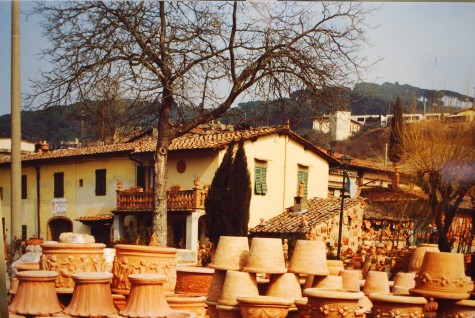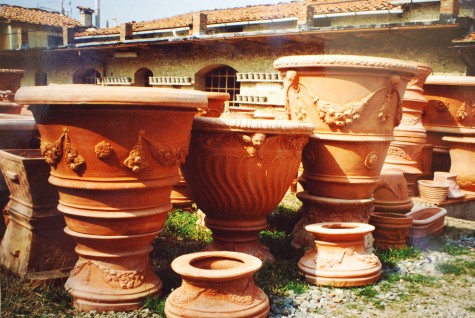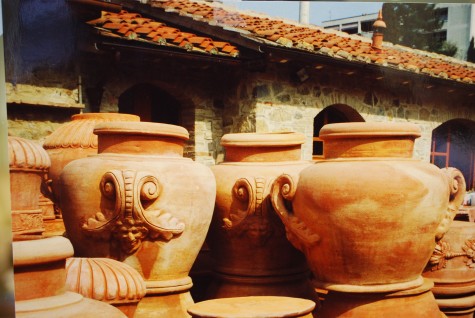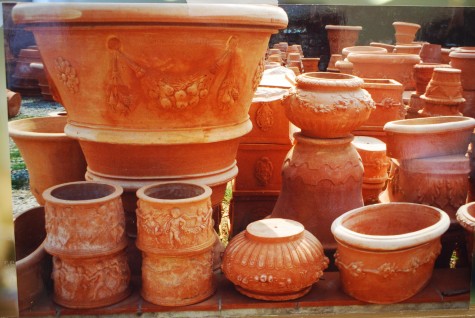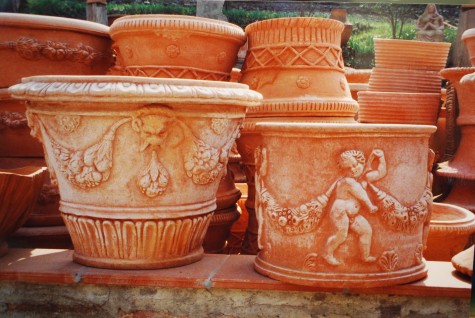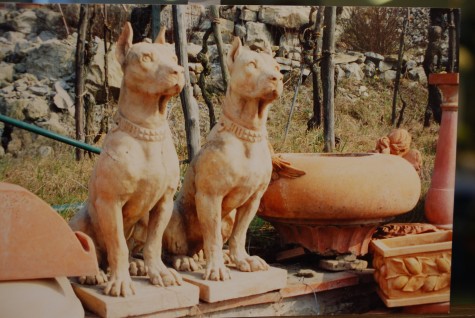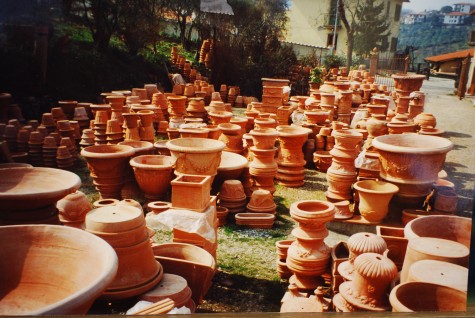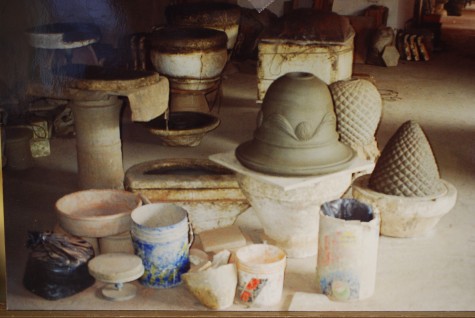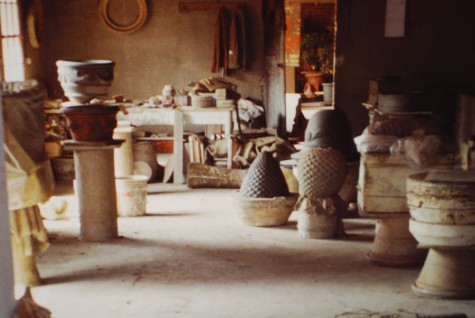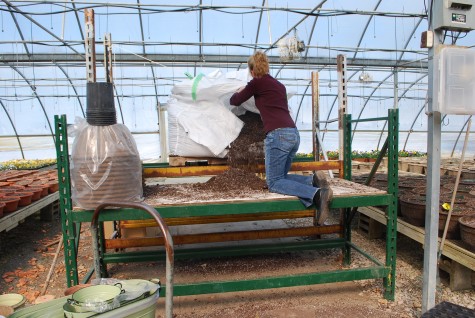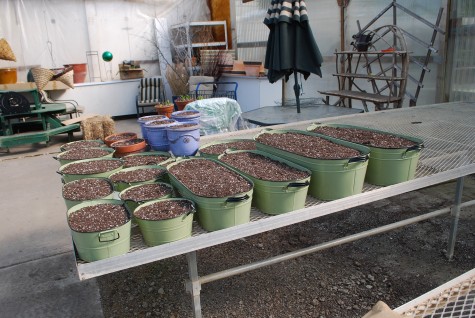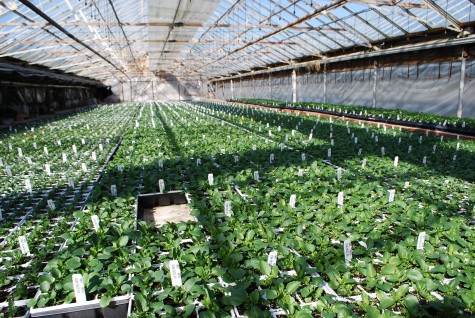
Rob’s first buying trip to Italy was in the fall if 1993-two years before I would buy the property and building that would become Detroit Garden Works. It was an exploratory trip in the truest sense of the word. The goal of the trip-see what was out there in terra cotta pots, and other garden ornament. I bought no end of European design magazines-that was just about the only way we could think of to search. We had no idea where he was going, and once he got there, what he would find. These pictures have a slightly blurry and romantic look for several reasons. These are my digital pictures of what Rob photographed with a 35mm camera 18 years ago. The other? The excitement he must have felt to see these pots in person is recorded in these pictures; I cannot really explain this any better. Eight months later 3 pallets of pots arrived. I was conducting my landscape business from my home then. Ralph and Kirk from GP Enterprises were kind enough to accept delivery at their commercial yard. I had never seen clay pots like them before. I felt like I had just met my intended. The 522 Italian terra cotta pots, 120 bowls, and 160 pot feet that were delivered 3 days ago? It feels just the same now as it did then-only better.
Archives for March 2011
At A Glance: The First Trip
Italian Terra Cotta
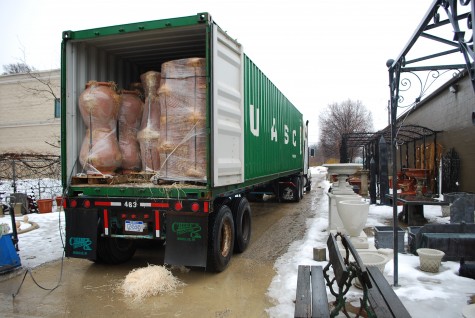 These three words-Italian terra cotta-are more than enough to get my attention, and make my heart pound. Terra cotte-translated literally from the Italian-fired earth. Pots fashioned from fired earth-what could be better? What better container in which to grow a plant? Containers from clay-what could possibly be more basic and natural? The clay pot is a gardening icon. I have stacks of them in my garage-I would wager that you do too. On occasion, a client will fill their trunk with unneeded clay pots, and bring them to me. Who could bear to throw one away? Crusty with age and use-all the better. I have yet to have a client insist on a brand new clay pot, if all I have in a size they need is a used pot. Used and vintage plain terra cotta pots provide just as good a home for a plant as a new one.
These three words-Italian terra cotta-are more than enough to get my attention, and make my heart pound. Terra cotte-translated literally from the Italian-fired earth. Pots fashioned from fired earth-what could be better? What better container in which to grow a plant? Containers from clay-what could possibly be more basic and natural? The clay pot is a gardening icon. I have stacks of them in my garage-I would wager that you do too. On occasion, a client will fill their trunk with unneeded clay pots, and bring them to me. Who could bear to throw one away? Crusty with age and use-all the better. I have yet to have a client insist on a brand new clay pot, if all I have in a size they need is a used pot. Used and vintage plain terra cotta pots provide just as good a home for a plant as a new one.
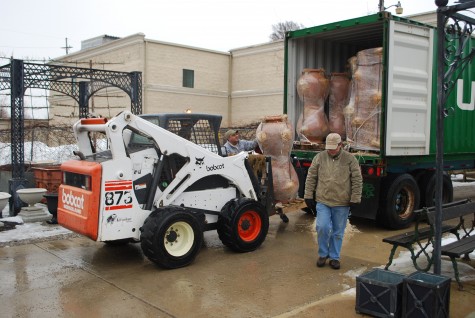 Italian terra cotta has been a part of my gardening life as long as I can remember. The machine made clay pots of my twenties were no nonsense sturdy and functional. Though the clay is fired, it is porous. The clay will wick moisture away from the roots of a plant. This can be helpful if you are a heavy waterer. If you don’t always get to watering whern you should, a glazed or other moisture conserving pot might be a better choice. That porousity also means that the container breathes; air is essential to proper root development. Machine made terra cotta will break if dropped, or left out over a Michigan winter. There are two critical factors that influence the durability of a clay pot. The quality of the clay is crucial. The best terra cotta pots on the planet come from Impruneta in Italy; the local clay is superior in quality. The other factor-the temperature and duration of the cooking. Fine handmade Italian terra cotta is fired upwards of 1700 degrees. The purpose of a long firing is a maturation process by which the pots are “soaked” with heat.
Italian terra cotta has been a part of my gardening life as long as I can remember. The machine made clay pots of my twenties were no nonsense sturdy and functional. Though the clay is fired, it is porous. The clay will wick moisture away from the roots of a plant. This can be helpful if you are a heavy waterer. If you don’t always get to watering whern you should, a glazed or other moisture conserving pot might be a better choice. That porousity also means that the container breathes; air is essential to proper root development. Machine made terra cotta will break if dropped, or left out over a Michigan winter. There are two critical factors that influence the durability of a clay pot. The quality of the clay is crucial. The best terra cotta pots on the planet come from Impruneta in Italy; the local clay is superior in quality. The other factor-the temperature and duration of the cooking. Fine handmade Italian terra cotta is fired upwards of 1700 degrees. The purpose of a long firing is a maturation process by which the pots are “soaked” with heat.
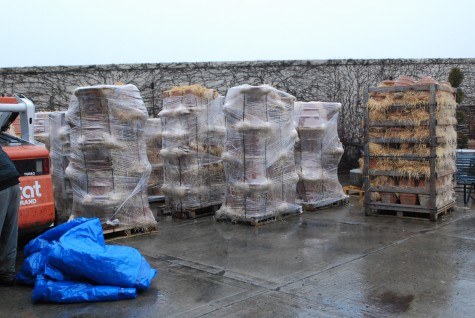 Machine made terra cotta has its place. They are available in an astonishing range of sizes and shapes. It is important to properly size a pot. Underpotting a plant leaves no root for root development. Overpotting a plant can result in the soil staying too wet for too long. Azalea pots and bulb pans are low and wide; this shape is specifically designed for shallow rooted plants that do well in less soil rather than more. Long toms (a reference to tomatoes) and rose pots are tall; they accomodate the long root runs of these types of plants. In any event, a classic clay pot is basic to anyone who grows plants. A handmade Italian terra cotta pot-an object of great beauty and durability.
Machine made terra cotta has its place. They are available in an astonishing range of sizes and shapes. It is important to properly size a pot. Underpotting a plant leaves no root for root development. Overpotting a plant can result in the soil staying too wet for too long. Azalea pots and bulb pans are low and wide; this shape is specifically designed for shallow rooted plants that do well in less soil rather than more. Long toms (a reference to tomatoes) and rose pots are tall; they accomodate the long root runs of these types of plants. In any event, a classic clay pot is basic to anyone who grows plants. A handmade Italian terra cotta pot-an object of great beauty and durability.

Delivered yeserday, an entire container of handmade Italian pots. The container is 40 feet long, by 10′ wide and 10′ tall. There were a whomping lot of pots on that truck. Why so many? Having a container delivered empty to the pottery means the packing costs are less; they pack and protect their pots quickly and expertly. Of the entire lot of hundreds of pots, one was broken. But the big issue is the volume. When we buy lots of pots direct from the manufacturer, we get a better price per pot. This helps make a handmade Italian terra cotta pot more affordable.
 Any wood that comes from overseas has to be heat treated, so no pathogens come along with the pots. Even the pallet wood is cooked. Likewise the excelsior-the pots are protected with wood shavings when they are stacked, and anywhere the steel strapping material touches a clay surface.
Any wood that comes from overseas has to be heat treated, so no pathogens come along with the pots. Even the pallet wood is cooked. Likewise the excelsior-the pots are protected with wood shavings when they are stacked, and anywhere the steel strapping material touches a clay surface.
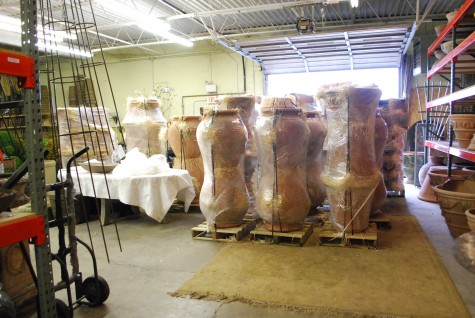 Each pallet is then shrink wrapped. I imagine the trip across the ocean on a boat can get dicey in bad weather. The durability of these pots helps make shipping them easier. Should you thump a terra pot, it should ring with almost a metallic sound. This tells you it is a high fire pot. Pots that thud when thumped-low fire.
Each pallet is then shrink wrapped. I imagine the trip across the ocean on a boat can get dicey in bad weather. The durability of these pots helps make shipping them easier. Should you thump a terra pot, it should ring with almost a metallic sound. This tells you it is a high fire pot. Pots that thud when thumped-low fire.
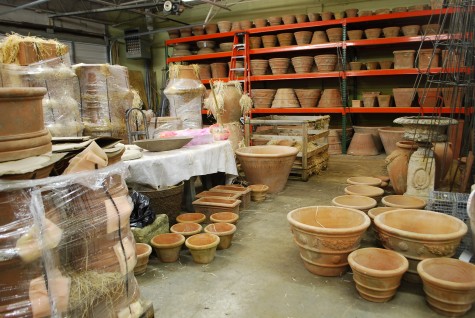 This is an embarrassment of riches in terra cotta pots, but it means someone who needs four matching, or 8 matching might find something they like. The soft orange color will beautifully compliment a planting. Their rugged good looks you will have for a very long time, given proper care. My own pots, but for 3 large English made concrete pots in the classical Italian style, are impruneta terra cotta. A beautiful clay pot is tough to beat. The first pallet of pots I bought 15 years ago was Italian terra cotta-I still remember what a thrill it was to unpack those 14 pots. They were very expensive, as is anything you bring over from Europe, a little at a time. But every one of them found a home, and many of them I am still planting for those clients.
This is an embarrassment of riches in terra cotta pots, but it means someone who needs four matching, or 8 matching might find something they like. The soft orange color will beautifully compliment a planting. Their rugged good looks you will have for a very long time, given proper care. My own pots, but for 3 large English made concrete pots in the classical Italian style, are impruneta terra cotta. A beautiful clay pot is tough to beat. The first pallet of pots I bought 15 years ago was Italian terra cotta-I still remember what a thrill it was to unpack those 14 pots. They were very expensive, as is anything you bring over from Europe, a little at a time. But every one of them found a home, and many of them I am still planting for those clients.
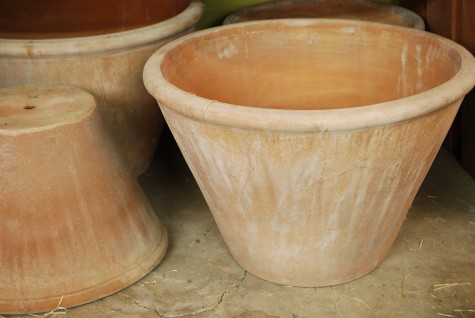
You may be wondering what about this pot enthralls me so much. It is not just the simple beauty of the form, the soft color and subtle surface.
 A beautifully planted Italian terra cotta pot can mean this for a garden.
A beautifully planted Italian terra cotta pot can mean this for a garden.
The Staddle Stones
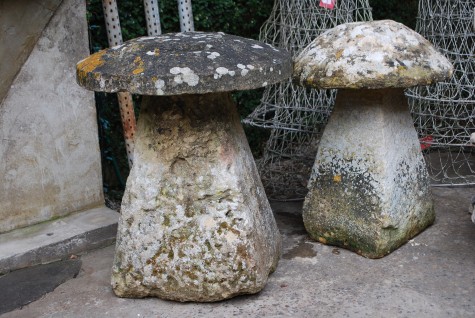 A collection of antique staddle stones arrived in the first container from England. They precisely represent what kind of garden ornament appeals to Rob the most. Any object with great age-that is instantly appealing to him. Add to that an architecturally arresting form and compelling surface-I can bet that object will be in my future. Our collection is modest-7 stones. They are greatly prized by gardeners and collectors of fine garden ornament.
A collection of antique staddle stones arrived in the first container from England. They precisely represent what kind of garden ornament appeals to Rob the most. Any object with great age-that is instantly appealing to him. Add to that an architecturally arresting form and compelling surface-I can bet that object will be in my future. Our collection is modest-7 stones. They are greatly prized by gardeners and collectors of fine garden ornament.
![gazebo_06[1]](https://deborahsilver.com/wp-content/uploads/2011/03/gazebo_061.jpg) Via Wikipedia, staddle stones were used as supporting bases for granaries, hay ricks, and game larders. These words are not part of my native vocabulary-but words of any kind relating to gardening interest me. These stones would elevate any number of structures with different purposes above grade. They would protect a store of grain, hay, or game from water, or vermin infestation. This photograph is courtesy of www.oakgazebo.co.uk; this structure is of of their design and manufacture.�
Via Wikipedia, staddle stones were used as supporting bases for granaries, hay ricks, and game larders. These words are not part of my native vocabulary-but words of any kind relating to gardening interest me. These stones would elevate any number of structures with different purposes above grade. They would protect a store of grain, hay, or game from water, or vermin infestation. This photograph is courtesy of www.oakgazebo.co.uk; this structure is of of their design and manufacture.�
 The origin of the word staddle? In middle English, staddle, or stadle derives from the word stathel, which derives from the the old English word stathol-a foundation, support, or trunk of a tree. I am thinking about the Tolkien novels right now-all of which I have read multiple times. OK, I have my quirks. A disclaimer here. I am not a scholar regarding the history of garden ornament. I am a horticulturist and landscape designer with 15 years of exposure to garden ornament of various kinds. This makes my knowledge of the history of garden ornament anecdotal. Sometimes I am way over my head. But these antique objects do interest me keenly-so I have made an effort to learn something about them. A stone carved to do the job of a trunk of a tree-I am interested in this.
The origin of the word staddle? In middle English, staddle, or stadle derives from the word stathel, which derives from the the old English word stathol-a foundation, support, or trunk of a tree. I am thinking about the Tolkien novels right now-all of which I have read multiple times. OK, I have my quirks. A disclaimer here. I am not a scholar regarding the history of garden ornament. I am a horticulturist and landscape designer with 15 years of exposure to garden ornament of various kinds. This makes my knowledge of the history of garden ornament anecdotal. Sometimes I am way over my head. But these antique objects do interest me keenly-so I have made an effort to learn something about them. A stone carved to do the job of a trunk of a tree-I am interested in this.
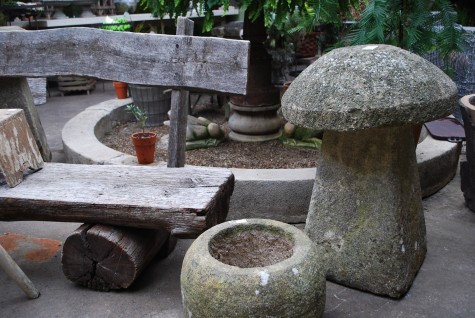 This particular staddle stone may look for all the world like a stone mushroom. Staddle stones placed in landscapes as ornament are actually described as stone mushrooms. But in fact, the domed top made it very difficult for rodents to climb into the granary. The flat top provides sturdy contact between the building, and the stone stilts.
This particular staddle stone may look for all the world like a stone mushroom. Staddle stones placed in landscapes as ornament are actually described as stone mushrooms. But in fact, the domed top made it very difficult for rodents to climb into the granary. The flat top provides sturdy contact between the building, and the stone stilts.
 They are very beautiful objects in their own right. But their shape was dictated by a need. An agricultural need. A cultural need. A way of life need. Nothing interests me more as a landscape designer than the intersection of nature, agriculture, horticulture, and landscape. I have spent a lot of time at that intersection-stop and learn. On the green signal, get going. Yield to oncoming traffic. Turn right on red-only when the coast is clear. Anyone who gardens professionally understands this dance perfectly. Any hands on gardeners understands this even better. These stones were carved from massive blocks of stone in a shape and size dictated by function. The stones are a visual essay in form simply following function.
They are very beautiful objects in their own right. But their shape was dictated by a need. An agricultural need. A cultural need. A way of life need. Nothing interests me more as a landscape designer than the intersection of nature, agriculture, horticulture, and landscape. I have spent a lot of time at that intersection-stop and learn. On the green signal, get going. Yield to oncoming traffic. Turn right on red-only when the coast is clear. Anyone who gardens professionally understands this dance perfectly. Any hands on gardeners understands this even better. These stones were carved from massive blocks of stone in a shape and size dictated by function. The stones are a visual essay in form simply following function.
 This photograph came from www.geograph.org.uk. It is a “web based project to collect and reference geographically representative images of every square kilometre of the British Isles”. What an ambitious project, and what a pleasure to be able to see such a structure. The brick building pictured above is held aloft by 9 staddle stones-so beautiful. Any building lifted off the ground by staddle stones-there is no small amount of calculation involved in determining how many staddle stones it takes to raise a building bearing weight above grade. A considerable requirement of stones for even a small structure meant a thriving local business for staddle stone carvers. The upper Hexford granary in Oxfordshire exists above grade courtesy of 36 staddle stones.
This photograph came from www.geograph.org.uk. It is a “web based project to collect and reference geographically representative images of every square kilometre of the British Isles”. What an ambitious project, and what a pleasure to be able to see such a structure. The brick building pictured above is held aloft by 9 staddle stones-so beautiful. Any building lifted off the ground by staddle stones-there is no small amount of calculation involved in determining how many staddle stones it takes to raise a building bearing weight above grade. A considerable requirement of stones for even a small structure meant a thriving local business for staddle stone carvers. The upper Hexford granary in Oxfordshire exists above grade courtesy of 36 staddle stones.
 Many of these stones are well over a century old. They are shaped from single blocks of stone. The individual shapes vary-there is always the evidence of the human hand. Our collection by and large was at some time carved from Cotswold stone.
Many of these stones are well over a century old. They are shaped from single blocks of stone. The individual shapes vary-there is always the evidence of the human hand. Our collection by and large was at some time carved from Cotswold stone.
 This photograph Rob sent me from England-compelling. These mushroom stones are truly mysterious and organic in shape-beautiful.
This photograph Rob sent me from England-compelling. These mushroom stones are truly mysterious and organic in shape-beautiful.
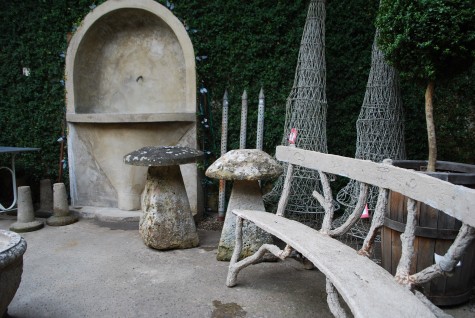
The antique staddle stones seem quite at home in the shop. They are breathtakingly beautiful-the historic use, the shapes, the surfaces, the color of the various stones,the lichens. They, among other things, make me so glad I decided to be a gardener.
Planting In March
I know I made much this past week about planting a more beautifully designed hanging basket. The challenge was such, I have the troubled dreams to prove it. All of the notes I made this past summer inexplicably disappeared. The lesson here-any idea, phrase, phone number, concept or design that you really need-write it down, and insure its safekeeping. Notes and notebooks, scrapbooks, file folders, magazine clippings-all of these are a good idea. Some ideas occur way ahead of their time. Keeping them written down, visually documented, and readily available is the best backup to insure that what is close to you heart gets a hearing when the time is right. Well, the time isn’t really right yet, but I was ready anyway.
I wanted to be past the dreams stage. It was time to put my show on the road. I drove out to Bogie Lake Greenhouse yesterday with Pam, and some containers in tow. I had an idea to plant some 50 containers for spring, in addition to the hanging baskets of my dreams. Ambitious, yes. But the big fact of the matter is, as Coach John Wooden once said, “It’s what you learn after you know it all that counts.” My big ideas got a dressing down. I am used to planting at the shop; I have already sorted through everything that Mark has available, and have at hand the plants that strike my fancy. This is a highly edited version of his greenhouse. Many of them are in color by the time I get them-I rarely buy plants from a list-I buy what I see, and like. Pam got right to work-she had all of the containers filled in no time. I was cruising the greenhouse with Mark, when reality began to sink in.
Spring plants in mid March are tiny green blobs-a few roots, and not much leaf to speak of on top. I faced an ocean of violas and pansies-all green. They are just where they need to be, perfectly timed-to be perfect in a month. I don’t know about you, but great color combinations in spring pots can be tough to achieve. The blues, lavenders, violets and red violets in pansies don’t always go together. Red violet pansies look great with red ornamental kale-dark purple pansies go blah. It became apparent that I would need to rely on my memory of color, my memory of the colors in the various mixes-or the notes that I could not find. If I was thinking I would have mature plants in color from which I could design-I thought wrong.
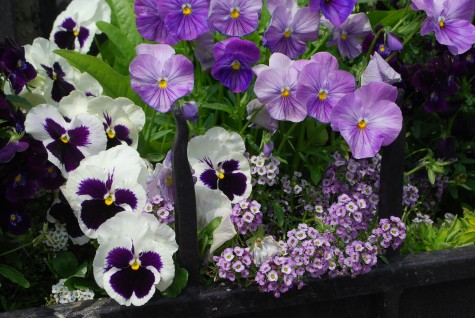 You can see from this picture that all of the purple in question has a decidedly red-violet cast. Do I know the names of these pansy and viola cultivars-no. Even when I did manage to match a cultivar name to a picture in a seed catalogue, I did not feel one bit better. Color pictures in a catalogue may give a feeling for a color-or not.
You can see from this picture that all of the purple in question has a decidedly red-violet cast. Do I know the names of these pansy and viola cultivars-no. Even when I did manage to match a cultivar name to a picture in a seed catalogue, I did not feel one bit better. Color pictures in a catalogue may give a feeling for a color-or not.
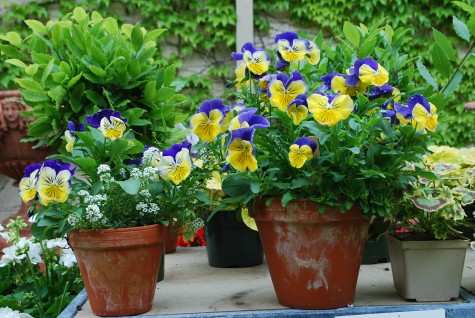 The purple is this bicolor pansy is not at all red violet. It has a heliotrope blue cast, to my eye. Red-violet alyssum in this pot would make me wince. Citron alyssum, which has a decidedly cream yellow cast, would have worked better than the white alyssum you see here.
The purple is this bicolor pansy is not at all red violet. It has a heliotrope blue cast, to my eye. Red-violet alyssum in this pot would make me wince. Citron alyssum, which has a decidedly cream yellow cast, would have worked better than the white alyssum you see here.
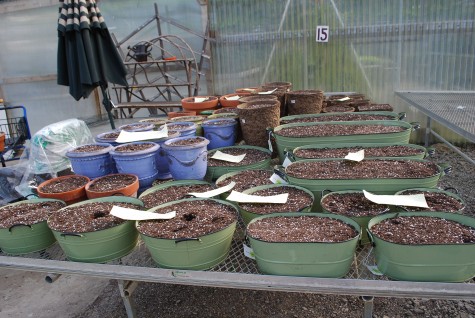 So I did what I could-all of the schemes came from my head and memory. Pam planted pairs of pots with a variety of spring annuals including pansies, violas, phlox, angelina, osterospermums and so on-and we’ll find out later if I can design in the dark. I didn’t even approach the hanging basket planting project-I see I have to plan them on paper. The time to plan combinations is at the height of the season-when color, texture and mature size is all right there to be seen.
So I did what I could-all of the schemes came from my head and memory. Pam planted pairs of pots with a variety of spring annuals including pansies, violas, phlox, angelina, osterospermums and so on-and we’ll find out later if I can design in the dark. I didn’t even approach the hanging basket planting project-I see I have to plan them on paper. The time to plan combinations is at the height of the season-when color, texture and mature size is all right there to be seen.
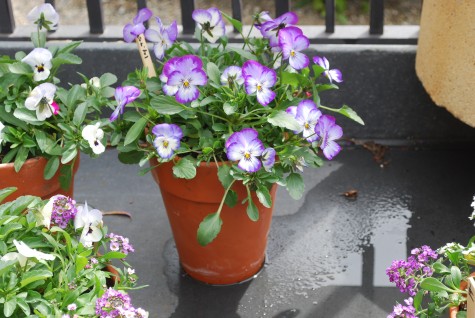
I have new resolve to photograph all of the flower cultivars I like to use-from the start of the season to the close. I will have then a catalogue of my own making, so I can plant green, if need me. We’ll see how far I get with that.
 Though these baskets are lush and well-grown, I have something different in mind. To that end, I’ll spend some time planning, before I plant.
Though these baskets are lush and well-grown, I have something different in mind. To that end, I’ll spend some time planning, before I plant.
